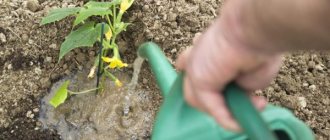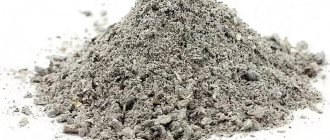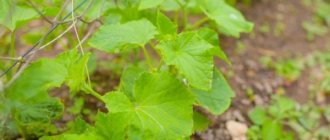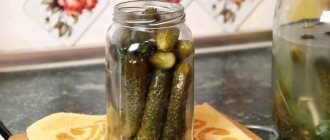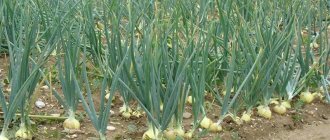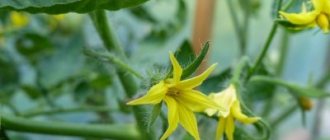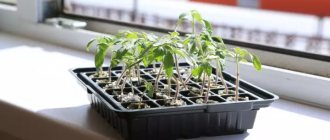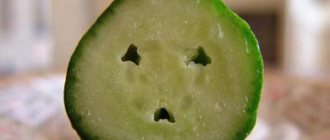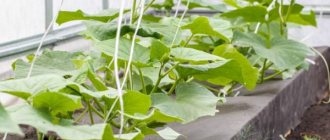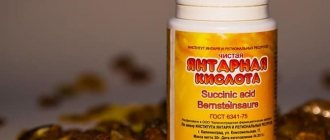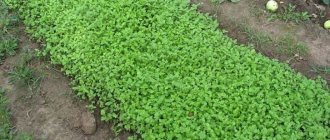Signs of micronutrient deficiency in cucumbers
When cucumbers do not have enough mineral fertilizers in the soil, the plants begin to react to their deficiency.
You can determine the lack of microelements in cucumbers in a photo of one or another element by looking at the foliage and vines. The photo shows that the foliage turns yellow, dries out and crumbles, brown spots appear, the stems look drooping - this is a clear lack of nutrition. Determining the lack of elements in a cucumber by leaves:
- The dark green leaves of cucumbers dry out at the edges, and a yellow border appears - a symptom of potassium deficiency.
- Signs of nitrogen deficiency: the lower leaves are drooping, the upper leaves have turned yellow and lightened. Cucumber bushes begin to lag behind in development, there are few fruits, they are small, the flowers are large.
- Red or orange shades form on the foliage, the interveinal space turns yellow - cucumbers lack magnesium. With severe deficiency, gray spots appear; between the veins, the green color changes to red or yellow. Leaves die and break.
- If the edges of the green leaves become lighter, curl, dry out, and light thin stripes have formed between the veins, then the cucumbers need calcium.
- The foliage turns a bluish-green tone, becomes dull, and a bronze color appears - this indicates a boron deficiency. The edges of the leaf blade curl into a tube and wrinkle. The first signs are visible on young stems and leaves. The leaf veins turn black and break when bent. The ovaries and fruits are deformed, the flowers fall off.
- Lack of phosphorus - the stems and leaves turn blue, the gloss disappears from the surface of the leaf. In severe cases, the foliage becomes purple or bronze in color. On the lower tiers, the leaves dry out and fall off, turning black. The shoots look drooping and weak.
- Old leaves become covered with yellow spots, curl at the edges, dry out - there is little molybdenum in the soil.
- Iron starvation - leaves turn yellow, the space between the green veins on the leaf blade turns white. Changes begin from the upper tiers of young leaves.
- Symptoms of copper deficiency: leaves and stems wither, starting from the upper tiers. White spots are visible on the leaf, the leaves are curled. New shoots do not appear, the top dies off.
- With zinc deficiency, the leaf turns yellow, bronze-colored spots may appear - this part of the leaf dies. Manifestation occurs on the lower leaves or stems. New leaves grow small in size with yellow spots, curled upward.
- Manganese deficiency can be determined by the leaves: the central vein remains green, the space between the veins becomes lighter or yellower. At first, the signs are visible on the upper leaves; over time, the pattern changes and stripes appear.
Important! It is necessary to respond to changes in the appearance of leaves on plants. Timely measures can correct the situation, and it will be possible to harvest a bountiful harvest of delicious greens.
Phosphorus [P]
Excess phosphorus
Excess phosphorus causes a general yellowing of the plant. Necrotic spots form and then the leaves fall off. The plant begins to age quickly. Potassium absorption occurs with a delay.
Lack of phosphorus in cucumbers
Phosphorus deficiency
Phosphorus deficiency is marked by dry spots formed on the lower leaves. The cucumber stops growing, the flowers and ovaries fall off.
Solution
For drip irrigation, phosphorus-potassium fertilizer should be used.
How to create a feeding schedule for greenhouse cucumbers
The nutrition of cucumbers needs to be approached comprehensively, then there will be no problems with the appearance of cucumber bushes, with their health and productivity. The table will help you create the correct reference schedule for applying fertilizers. It takes into account all phases of cucumber development. The compositions are intended for application under the root.
| Composition no. | Composition ingredients | Phase |
| 1 | Urea - 15 g | 2-3rd sheet |
| Double superphosphate - 25 g | ||
| Potassium sulfate – 15 g | ||
| Water - 10 l | ||
| 2 | Nitrophoska - 30 g/m² | 3-4th sheet |
| 3 | "Aquarin" - 5 g | |
| water – 10 l | ||
| 4 | "Agricola-5" for cucumbers - 2 tbsp. l. for 10 liters of water | |
| 5 | "Agricola-5" for cucumbers - 2 tbsp. l. for 10 liters of water | Budding |
| 6 | Double superphosphate - 25 g | |
| Potassium sulfate - 20 g | ||
| Ammonium nitrate - 15 g | ||
| Water - 10 l | ||
| 7 | Potassium sulfate - 1 tsp. | Bloom |
| Superphosphate - 1 tsp. | ||
| Urea - 1 tsp. | ||
| 8 | "Effecton-O" - 2 tbsp. l. | |
| Water - 10 l | ||
| 9 | Boric acid - 0.5 g | |
| Manganese sulfate - 0.4 g | ||
| Zinc sulfate - 0.1 g | ||
| Water - 10 l | ||
| 10 | Potassium nitrate - 30 g | Fruiting |
| Urea - 50 g | ||
| Ash - 1 tbsp. | ||
| Water - 10 l |
Cucumbers respond well to spraying nutrient mixtures on the leaves. You can use a proven scheme. It consists of 3 stages. The first occurs at the beginning of flowering. All solution ingredients are given for 10 liters of water:
- potassium permanganate - 12 crystals;
- boric acid - 1 tsp.
The second stage of fertilization occurs during the initial phase of fruiting. At this time, the bushes should be sprayed with a daily infusion of ash. It is prepared from 10 liters of water, 1 tbsp. ash. The third stage coincides with a decrease in yield. Cucumbers in the greenhouse are reanimated with urea solution. You need 15 g of it per 10 liters of water. Fertilizers should be applied to the roots after watering. Spray cucumber leaves before 11 am.
Unfortunately, not only does a deficiency of nutrients affect the appearance of the fruit, but an excess also turns out to be harmful. Experienced gardeners can determine the lack of nutrition in plants using a visual method.
The problem first appears as a change in the color of the leaf blade. If the deficit is not eliminated at this moment, it will be impossible to achieve a beautiful looking fruit.
In addition to basic nutrients, plants may lack moisture and microelements, as well as oxygen in the soil. With various kinds of deficiencies, cucumbers are susceptible to fungal diseases, grow poorly, and are tasteless. The quality of the fruit may deteriorate if the seedlings are planted in a dark place, for example, under a tree.
With a lack of nutrients, fruit quality suffers
Gardeners can understand in advance what the problem is and take action, as plants begin to signal by changing the color of the foliage. The earlier the problem is noticed, the more likely it is that it will not affect the appearance of the fruit and they will not lose their presentation.
Lack of fertilizers for cucumbers
A lack of nutrients in cucumbers occurs if the soil is used intensively and its fertility is not restored. They solve the problem with the help of simple and complex fertilizers.
Potassium deficiency
The lack of this element in the soil affects the harvest. There are few fruits and they are of low quality. The growth of lashes is large, but there are no ovaries on them, the leaves acquire a dark green color, they have a yellow, dry border.
Bushes can be fed in three ways:
- Prepare an infusion of ash. Stir 2 glasses into 10 liters of water.
- Use a solution of potassium salt. To prepare it, stir 3 tbsp in a bucket of water. l. fertilizers
- They take potassium magnesium and prepare a 1-3% composition. This fertilizer can be applied directly to the soil at a dose of 20 g/m². Do this several times throughout the summer.
Nitrogen deficiency
If this element is not enough, then the plant lags behind in development. The stems are fibrous, long, but thin. In the lower tier the leaves are drooping. Those located in the upper part of the bush have turned yellow or began to lighten. There are few ovaries, the fruits are small, and the flowers, on the contrary, are enlarged.
You can solve the problem with mullein solution. You need 1 part to 10 parts water. To feed 1 cucumber bush you need 1 liter of manure infusion. At the same time, cucumbers should be sprayed with calcium nitrate (2% solution) once every 14 days.
Magnesium deficiency
Uneven leaf color (light and dark spots) indicates a lack of magnesium in cucumbers. It is urgent to decide what to treat. Many biochemical processes depend on this element; it affects carbohydrate metabolism and is found in chlorophyll.
The reason for these changes is a failure in the complex process of photosynthesis caused by magnesium starvation. To normalize nutrition, foliar treatments with fertilizers containing Mg are used. They save the situation with magnesium sulfate, potassium magnesium, and ash.
Calcium deficiency
Young, newly formed leaves will help determine the deficiency of this element. They have a dark green main background, light edges, and thin light stripes visible between the veins. Calcium is involved in cell formation. If there is a lack of it, the ovaries do not develop, and the taste of the fruit deteriorates.
Calcium nitrate solution can eliminate calcium starvation:
- water - 10 l;
- calcium nitrate - 25 g.
Boron deficiency
Boron (B) affects the synthesis of carbohydrates, so the taste of the fruit depends on it. Its deficiency affects productivity. A lot of barren flowers appear, and the greenery becomes smaller. Its deficiency can be caused by a number of reasons:
- heavy rains washing it out of the soil;
- land depleted by many years of use;
- liming;
- excessive application of nitrogen, phosphorus, and potassium fertilizers.
Gardeners fill the cucumber's need for this element with boric acid. This microfertilizer stimulates the growth of the root system, strengthens shoots, promotes the formation of buds and ovaries, and facilitates the absorption of nitrogen. The use of boric acid in a greenhouse or vegetable garden can increase the yield by almost 20%.
Phosphorus deficiency
If some of the leaf blades have brown edges and many of the leaves have died, then the bushes need to be urgently watered with superphosphate infusion. It dissolves in hot water, so 5 tbsp. l. You need to steam it with boiling water overnight, and in the morning pour this concentrate into a bucket of water (10 l).
Molybdenum deficiency
Vegetable crops growing in acidic soil experience a lack of molybdenum. It can be caused by sulfate fertilizers. They acidify the soil. A high concentration of manganese can provoke molybdenum starvation.
Iron deficiency
You can replenish iron deficiency with iron sulfate. To prepare the solution, you need to dissolve 5 g of powder in 10 liters. You can recognize starving bushes by their light yellow, almost white leaves located at the top of the stem.
Deficiency of copper, zinc and manganese
By weak, limp shoots, pale leaves, and crumbling buds, you can understand that the plant lacks copper (Cu). If a plant receives this element in excess of the norm, then its leaves begin to fall off.
Unsymmetrical leaf blades and yellowish coloration of young leaves are signs of zinc starvation. These manifestations are too vague. An inexperienced gardener simply will not be able to identify them. Signs of boron and manganese deficiency can occur against the background of excess calcium.
A lack of manganese will affect the size of the fruit and the growth of shoots. This element directly affects breathing and is involved in the process of assimilation of carbon dioxide. The deficiency is manifested by the appearance of individual light spots on the leaves growing in the upper part of the stem.
Zinc
The optimal amount of nitrogen in the soil can lead to zinc deficiency. An insufficient amount of the element directly affects the taste and shape characteristics of the fruit. Cucumbers are formed in an ugly shape. The peel becomes thicker than usual, and the flesh of the fruit itself has a bitter taste. The leaf blade also changes, acquiring an asymmetrical color.
It is enough to carry out root feeding with the optimal concentration of zinc sulfate - 30 mg of the product is diluted in 10 liters of water. The result of a balanced amount of microelement will be visible after the first time of applying fertilizer.
Signs of a lack or excess of microelements in cucumbers
A lack of microelements causes changes in the appearance of the bushes: their leaves change color, the fruits can become deformed and acquire a taste that is far from the varietal characteristics. In most cases, upon careful examination of the leaf blades and the nature of the change in the shape of the fruit, one can draw conclusions about what the cucumbers lack.
With insufficient nutrition, this crop produces deformed fruits. Often, by the twisted and irregular shape of the fetus, you can determine what exactly is missing.
- Cone. This curved shape of the cucumber is characterized by the pointedness of the fruit. If the tail of the fruit becomes pointed at the point where the flower is attached, this means that the bushes are experiencing a nitrogen deficiency. The fruit may look like a kind of hook.
- Pear. Pear-shaped cucumbers are characterized by a club-shaped shape that tapers towards the base and a spherical bulge at the other end of the fruit. This symptom most often indicates a deficiency of potassium nutrition.
The first sign of an unhealthy plant condition is a change in the appearance of the leaf blades. Most often, the lack of nutrients appears first on old adult leaves, and then affects young leaves. Changes can be seen in the outer covers of the plates: their structure, size and color change:
- if the leaf becomes dry and yellow, magnesium or nitrogen starvation may occur. If there is a dry edge only along the edge of the leaf, there is a potassium deficiency;
- bright yellow color characterizes iron deficiency;
- darkening of the leaves to a blue-green hue and a change in color to purple - phosphorus deficiency;
- If cucumbers have small leaves, they lack nitrogen.
Yellowing of lower leaves
If the seeds were planted in depleted soil, the seedlings may experience a lack of nutrients. A deficiency of a particular element at the seedling stage can be identified by the condition of the leaves and growth rate:
- yellowing of the lower leaves of seedlings signals a deficiency of one of the nutrients: potassium, phosphorus or magnesium;
- if the upper part of the bushes turns yellow, they may lack microelements in the soil (iron, boron, etc.);
- with a lack of nitrogen, seedlings grow slowly and look frail;
- elongation and thinness of the stems indicates a deficiency of potassium-containing fertilizers.
Also check out these articles
- Plum propagation
- Onion diseases
- Aktara insecticide
- Marigold flowers
- The plant slows down its development and may not grow to a normal size, that is, it will be distinguished by dwarfism.
- There are few ovaries, and there is very little pollen on the flowers.
- The buds and ovaries quickly fall off.
- The side shoots dry out and become brittle.
- Internodes are shortened.
- Cucumbers grow small and crooked.
- The taste of greens is average.
Important!
Primary signs of boron deficiency cannot be noticed. At this stage, the cell walls increase, which increases the content of pectin substances in them. After this, symptoms of deficiency appear that gardeners can notice.
It should also be noted that if the cucumbers have not received enough boron since sowing the seeds, they will have an underdeveloped root system. Such plants grow slowly, are more capricious, require frequent watering and fertilizing, and produce little yield.
Signs of deficiency and excess of boron in cucumbers
Main causes of color loss
When considering possible reasons, you need to take into account that it can be either one reason or several at the same time. If there is a lack of one or another nutritional element, the plant organism’s immunity weakens. He can no longer fight insect pests or pathogens with all his might. That is why it is necessary to track the entire chain of possible pathologies.
The causes of yellowing foliage may be:
- lack of essential microelements for cucumber (nitrogen, potassium, phosphorus);
- inability to absorb microelements;
- lack of sunlight. In this case, the leaf begins to turn yellow from below;
- drying out of the top layers of soil and root system;
- excessive waterlogging and, as a result, rotting of cucumber roots;
- violation of temperature and humidity balance.
Lack of microelements
Just yesterday the green leaf plate of the cucumber was bright and juicy, but today the vegetable grower can observe that the leaves have become paler over the entire surface or in the veins
It is also important to pay attention to exactly how the yellowing spreads relative to the height of the plant.
Micronutrient deficiency is a relative concept. The soils are very rich in minerals. Their reserves will last for thousands of years. But their deficiency for the plant is associated with the inability of the cells of the root system to assimilate this or that element.
Global soil mineralization and a lack of organic fertilizers introduce an imbalance in the soil structure, and the plant responds to this by yellowing of the foliage.
Signs of a specific element being deficient
The plant whip quickly reacts to the lack of one or another nutrient. The leaf is an index. Upon careful examination, you can detect the following signs of starvation:
Bor
Young foliage will be the first to indicate a deficiency. The apical leaves of the cucumber will be chlorotic and pale yellow in color. In this case, flowering will be weak, and the resulting green plants will turn yellow and fall off.
Nitrogen
Nitrogen starvation is manifested by the blanching of the leaves of the entire cucumber vine. In addition, pallor will be characteristic of the entire cucumber plantation.
The deficiency begins to appear from the lower leaves. Dry spots gradually merge and the leaf falls off.
Potassium
If the absorption of this element is poor, it is not the leaves that turn pale, but their edges. Potassium is a mobile element, so the plant is able to transfer it from the periphery of the leaf blade to the center.
Copper
If cucumbers are sown on red soil, then copper deficiency is impossible. But sand, loam, and sandy loam cannot always provide a cucumber with copper.
Copper provides the plant with the processes of photosynthesis and respiration, and affects the vascular system of cucumber vines. Copper starvation cannot always be determined by foliage, but a small number of flowers and ovaries will tell the vegetable grower about the need for fertilizing.
Manganese
This element does not manifest itself by yellowing of the foliage. If there is a deficiency, the veins of the cucumber leaf become dark burgundy in color.
Calcium
With a deficiency of this element, pale stripes are located along the leaf and form a clearly visible stripe.
Zinc
Soils rich in humus completely provide the cucumber with zinc. The availability of the element in acidic soils is higher than in alkaline soils.
Cucumber is not very sensitive to zinc deficiency. In addition, if the level of nitrogen in the soil is optimal, then zinc starvation is impossible.
Iron
Lack of this element occurs extremely rarely and is accompanied by blanching of the apical leaves.
Soil care
Light cucumber leaves should alert you
Initially you should pay attention to:
- air permeability of soils, loosening and weeding;
- water balance. When the soil dries out, the absorption of minerals stops; the cucumber needs daily watering;
- pre-sowing activities. By enriching the soil with humus and ash before digging, you can significantly improve the soil structure and productivity.
It is very difficult to visually determine the excess of one or another element. By conducting a chemical analysis, we can clarify the problem.
It is generally accepted that cucumber, like other plants, selectively absorbs minerals necessary for vegetation and fruiting. An excess of these elements is extremely rare.
How to determine the lack of microelements in cucumbers and how to deal with it
Reading time: 10 minutes
The need of plants for microelements is small in quantitative terms, but without them metabolic processes in cells are disrupted. The yield of cucumbers directly depends on the provision of adequate nutrition, and the demands of the crop change throughout the season. Soil rich in rotten organic matter and complex mineral fertilizers contain the necessary substances, but not always in optimal amounts.
In addition to large supplies of macronutrients (nitrogen, potassium, phosphorus), cucumber plants need:
- in moderate amounts of the so-called mesoelements (calcium, magnesium and sulfur);
- in mini doses of microelements (boron, manganese, iron, copper, zinc, molybdenum, cobalt, silicon, iodine).
The last two groups are often combined under the general term “microelements”. Their deficiency reduces the productivity of cucumbers.
THE APPEARANCE OF CUCUMBER PLANTS SIGNALS TO THE VEGETABLE GROVER ABOUT A SHORTAGE OF SPECIFIC MICROELEMENTS. THE SITUATION CAN BE CORRECTED BY APPLYING SPECIAL FERTILIZERS.
Sulfur
Sulfur starvation is similar to nitrogen starvation: the growth of plant cells slows down and many metabolic processes are disrupted.
Sulfur is part of organic matter - humus acids, and therefore is present in sufficient quantities in humus-rich soils. Little mineral and organic sulfates are found in sandy loams, as well as in poor soddy-podzolic soils with increased moisture.
Symptoms of deficiency:
- Leaves (especially young ones) turn pale along with the veins, but do not fall off (unlike nitrogen deficiency).
- The leaf blades are bent downwards.
- Pronounced notches appear along the edges of young leaves.
- The ovaries grow too slowly.
Solution to the problem:
- Cucumber plants are given foliar feeding with Magnesium Sulfate (6 g per 3 liters of water), repeat after 10 days.
- For prevention, before planting cucumbers, the soil is filled with a fertilizer such as simple superphosphate (0.5 kg per 10 sq. m). It contains a sufficient amount of sulfates.
If there is too much sulfur, plant tissues become rough, stems harden, and leaves become smaller.
Excess of microelements
Too much mineral content in the soil is just as harmful to the plant as its deficiency. Typically, this situation occurs in the case of overfeeding with fertilizers and oversaturation of the soil. Failure to comply with the dosage of fertilizers, violation of the timing and frequency of fertilizing - all this leads to excessive mineral content.
Iron. Excess iron is very rare and usually causes difficulty in absorbing phosphorus and manganese. Therefore, the symptoms of an excess of iron are similar to the symptoms of a deficiency of phosphorus and manganese: a dark, bluish tint of the leaves, cessation of plant growth and development, and the death of young shoots.
Magnesium. If there is too much magnesium in the soil, calcium ceases to be absorbed; therefore, the symptoms of an excess of magnesium are generally similar to the symptoms of calcium deficiency. This is the curling and dying of leaves, a curved and torn shape of the leaf plate, and a delay in the development of the plant.
Copper. If there is an excess of copper, brownish spots appear on the lower, older leaves; subsequently, these areas of the leaf, and then the entire leaf, die. Plant growth slows down significantly.
Zinc. When there is too much zinc in the soil, the plant leaf becomes covered with whitish watery spots on the underside. The leaf surface becomes bumpy, and subsequently the affected leaves fall off.
Bor. Excessive boron content appears primarily on the lower, older leaves in the form of small brownish spots. Over time, the spots increase in size. The affected areas, and then the entire leaf, die.
Molybdenum. If there is an excess of molybdenum in the soil, the plant does not absorb copper well, so the symptoms are similar to those of copper deficiency: general lethargy of the plant, slow development of the growing point, light spots on the leaves.
Manganese. Excess manganese in its symptoms resembles magnesium starvation of a plant: chlorosis on older leaves, spots of different colors on the leaf blade.
Nitrogen. Too much nitrogen leads to rapid growth of green mass to the detriment of flowering and fruiting. In addition, an overdose of nitrogen in combination with excessive watering significantly acidifies the soil, which in turn provokes the formation of root rot.
Phosphorus. Excessive amounts of phosphorus interfere with the absorption of nitrogen, iron and zinc, resulting in symptoms characteristic of a deficiency of these elements.
Potassium. If the soil contains too much potassium, the plant stops absorbing magnesium. The development of the plant slows down, the leaves acquire a pale green color, and a burn occurs along the contour of the leaf.
Calcium. An excess of calcium manifests itself in the form of interveinal chlorosis. This happens because too much calcium leads to difficulty absorbing iron and manganese.
Iron
Iron compounds are involved in various metabolic processes of plant tissues (photosynthesis, protein production, etc.).
Many types of soils, especially carbonate ones, contain forms of this microelement that are inaccessible to plants. Organic fertilizers are not suppliers of iron; it is advisable to apply it in the form of chelated microfertilizers.
Symptoms of deficiency:
- The growing leaves turn pale and then turn yellow. The veins initially remain green, but subsequently also lose color. There may be a fall of yellowed young foliage while retaining the old greenery.
- The ovaries become weak and few in number.
Solution to the problem:
- A quick effect is achieved by combining foliar and root fertilizing with iron chelate (according to the instructions for the preparation).
- Iron sulfate as a fertilizer is poorly absorbed by vegetable crops. It is better to prepare a chelate form from it by mixing 5 liters of water, 5 g of citric acid and 8 g of Iron sulfate (use immediately).
Expert opinion
Stanislav Pavlovich
Gardener with 17 years of experience and our expert
Ask a Question
INTERESTING! Symptoms of iron excess almost coincide with the signs of iron deficiency.
The role of microelements
It is easiest to notice on young foliage. The very top of the cucumber becomes lightened, small leaves become light yellow and even pale, the plant significantly slows down the growth and formation of flowers.
Iron deficiency can be compensated for by root feeding. A 5% solution of iron sulfate is used for this. Leaf plates can be sprayed with a solution of ash and soap.
Weak, sluggish shoots on which light leaves are located indicate a lack of copper. Another sign of deficiency is crumbling buds. For prevention, before planting seedlings, add a 1% solution of copper sulfate to the soil. You can also feed leaf by leaf. Only the solution needs to be taken at 0.5%.
Manganese is directly involved in the absorption of carbon dioxide by cucumber. Symptoms of deficiency include small yellow spots on the top leaves of the plant. The fruits grow small, the shoots slowly increase in mass. The plant needs to be fed with a manganese solution (0.3 mg/liter).
Growth and fruiting are negatively affected by both deficiency and excess of nutrients. Although the shares that the table contains are not equal, each of them is involved in processes vital for the plant and cannot be replaced.
Due to a lack of microelements, cucumbers often develop various manifestations of chlorosis. This is a disease in which the formation of chlorophyll, necessary for the process of photosynthesis, is disrupted, especially when grown in a greenhouse. The leaves lose their uniform green color, turn yellow and subsequently die.
Magnesium
In cucumbers, the need for magnesium increases during the fruiting phase. A lack of microelement leads to the destruction of chlorophyll and rapid aging of plants.
Many soils contain insufficient amounts of available magnesium compounds, especially acidic, sandy loam and light soddy-podzolic soils.
Symptoms of deficiency:
- Interveinal chlorosis occurs: the leaf blades turn pale and yellow, but the veins remain bright green. The process first affects the lower leaves, and in advanced cases spreads to the upper ones.
- Petioles and shoots of plants become fragile and break easily.
- Cucumbers grow atypically small.
IMPORTANT! Fertilizing with organic matter (manure, droppings, herbal infusion) is not able to quickly relieve acute symptoms of magnesium deficiency.
Solution to the problem:
- Cucumber plants should be sprinkled and watered at the root with one of the following preparations: Magnesium sulfate, Kalimag, Mag-Bor (10 g per 5 liters of water). Feeding is repeated after one and a half to two weeks.
- In a greenhouse, you can use an aerosol microfertilizer - a “Greenhouse” tablet.
- Prevention required:
- on acidic soils, spread Dolomite flour in the fall (this deoxidizer is rich in magnesium);
- Regular application of manure humus gradually enriches the soil with magnesium compounds.
Excessive doses of magnesium lead to darkening, wrinkling and reduction in the size of leaf plates.
Feeding cucumbers in a greenhouse
To feed cucumbers at the root, a higher concentration of substances is used than for spraying the foliage. In cold weather, fertilizers are useless; in cold weather, the root system of cucumbers does not work. It is better to underfeed your plants than to overfeed them. Seedlings begin to be fed from the first 2 weeks; after being transferred to the greenhouse, cucumber seedlings are fed 3-4 times.
Sequence of applying fertilizer for cucumbers:
- seedlings are fed 15 days after transplanting into a greenhouse, potassium and nitrogen are used;
- fertilize the second time during budding, potassium, phosphorus, magnesium, boron are needed;
- the third additive comes during fruit formation; complex fertilizers are required;
- the fourth time the additives are added 2 weeks after 3 times of fertilizing, nitrogen, phosphorus, and potassium are added.
Cucumber feeding table
| The missing element | Foliar nutrition | Root feeding |
| Nitrogen | Urea solution - 5 tbsp per bucket of water. spoons | Dissolve 30 g of urea in 10 liters of water. |
| Phosphorus | Superphosphate 60 g per 9 liters of water | Ammophos teaspoon per 1 liter of water |
| Potassium | Dilute 8 g of potassium sulfate in 9 liters of water | 20 g of potassium sulfate per bucket of water |
| Iron | Sprayed with ash solution | Iron sulfate 5% |
| Magnesium | Magnesium nitrate 100 g per 10 liters of water | 20 g Kalimaga diluted in a bucket |
| Bor | Boric acid 2 g per 10 liters of water | Dilute 5 g of boric acid in 9 liters of water |
| Molybdenum | Ammonium molybdate – 0.02 g per 10 sq. m. | Ammonium molybdate 1 g per 10 liters of water |
| Calcium | Complex fertilizers | Calcium nitrate 25 g per 9 liters of water |
| Copper | Copper sulfate, concentration 0.05% | Copper sulfate – 1 g per 1 sq. m. or per 1 liter of water 0.2 g of substance |
Important! All foliar spraying is carried out before flowering begins.
To make the cucumbers tasty and the harvest to be plentiful, you need to add a complex of microelements to the soil regularly. When the first signs of a lack of elements appear, it is necessary to fertilize the cucumbers in a timely manner. The main 3 components potassium, nitrogen and phosphorus will be needed throughout the growing season. Even after harvesting vegetables, fertilizers are applied to the ground for digging, so that next year new seedlings can be planted and a rich harvest of greens can be grown.
Manganese
This microelement is concentrated in young organs and participates in metabolic processes, accelerating plant development. Manganese deficiency leads to disruption of carbohydrate synthesis, which negatively affects the condition of the root system.
Peat and sandy loam soils contain little manganese. Organic fertilizers (manure, droppings) enrich the soil with useful manganese compounds.
Symptoms of deficiency:
- Areas of dead tissue appear on the leaves in the form of small dots.
- The foliage gradually becomes “marbled” - pale yellow with dull green veins.
- When young leaves grow, they have a light green or greenish-brown color, then a narrow yellow border appears on them.
Solution to the problem:
- We recommend foliar feeding with special microfertilizers - manganese chelate or manganese sulfate (manganese sulfate), according to the instructions for specific preparations.
- Potassium permanganate (Potassium permanganate, Potassium permanganate) is used as a folk remedy; Cucumber plants are sprayed with a solution in a proportion of 1 g per 5 liters of water.
IMPORTANT! The best option for replenishing the microelement deficiency is manganese chelate. Overdose leads to the appearance of purple spots on leaves and fruits, rapid aging and death of cucumber plants
This should be remembered by vegetable growers who are fond of disinfecting soil watering with potassium permanganate.
An overdose leads to the appearance of purple spots on the leaves and fruits, rapid aging and death of cucumber plants. Vegetable growers who are fond of disinfecting soil watering with potassium permanganate should remember this.
calcium deficiency
signs of calcium deficiency
- At first, the young leaves are dark green, but small;
- with further starvation, the edge of the leaf turns white;
- the tissues between the veins lighten and gradually die;
- the veins and part of the tissue near them remain green for some time;
- the edges gradually bend downwards and become brittle;
- If the situation is not corrected, the roots stop growing and the top dies.
calcium deficiency in cucumber
Plants cannot transfer calcium from old leaves to young ones, as happens with nitrogen. Calcium moves to those parts of the plant that actively evaporate moisture. Therefore, with Ca deficiency, it is the young shoots and leaves that suffer first, since they take little or no part in evaporation.
calcium deficiency treatment
It is necessary to deoxidize the soil, since acidic soils are characterized by Ca deficiency. In addition to deoxidation, you can use the drug Fitovert Energy - it is balanced in the composition of important nutrients, which are in the form and proportions required by plants. Foliar feeding with the drug is carried out 2-3 times every week.
Variety of fertilizers
Many gardeners prefer to feed cucumbers exclusively with organic fertilizers. Mullein, manure infusions and bird droppings are the main raw materials for them to create fertilizers. However, in the case of cucumbers, such fertilizers are not enough, since organic matter contains a lot of nitrogen and an insufficient amount of other microelements. That is why, even when using organic matter, you should not neglect mineral supplements.
In agricultural stores, gardeners are offered complex preparations and certain nutrients. Depending on the task at hand, you should choose one or more of them:
- Sources of nitrogen include ammonium nitrate and urea, which is sometimes called urea. For a one-time application to the soil, these substances are diluted in a bucket of water in the amount of 10-20 g and 20-50 g, respectively. The concentration of fertilizing largely depends on the age of the plant and its condition.
- Superphosphate is often used to feed cucumbers with phosphorus. This microelement is added to the soil at the rate of 40-50 g/m2.
- You can compensate for the lack of potassium in cucumbers using potassium sulfate or potassium magnesium (a combination of potassium and magnesium). These substances do not contain chlorine harmful to cucumbers. A nutrient mixture is prepared from them at a concentration of 1-3%. A large amount of potassium is contained in wood ash, which can be used in dry or liquid form (infusion) to feed cucumbers.
- The lack of boron can be compensated for either with boric acid or with a special preparation Biochelate-Boron. The boron concentration in the fertilizer should not exceed 0.02%. For example, only 0.2 g of the substance is added to 1 liter of water. Boron is toxic and, if the dosage is exceeded, can negatively affect the growth and development of cucumbers.
- You can saturate cucumbers with magnesium using potassium magnesium. During the season, in several stages, this substance should be applied in a volume of 15-20 g for every 1 m 2 of soil. Dolomite flour and wood ash also contain large amounts of trace elements. The consumption of these substances per season per 1 m 2 of soil should be 20-50 and 30-60 g, respectively.
- Manganese for cucumbers can be obtained by diluting a weak, light pink solution of potassium permanganate (potassium permanganate).
- Calcium can be added to the soil using calcium carbonate in the amount of 5-7 kg per 10 m 2 of soil. The microelement is also found in chalk, dolomite flour, and wood ash. To feed cucumbers at home, you can prepare flour from eggshells.
To feed cucumbers, you can use a specific substance or prepare a complex mixture of microelements in the required concentrations. When preparing fertilizers for young plants, special care must be taken, since they are very sensitive to overdoses.
On sale you can find combined fertilizers that combine the necessary microelements in a certain amount. The most widely used of them is ammophosphate - a three-component fertilizer that contains nitrogen, potassium and phosphorus. You can prepare such a mixture yourself by mixing ammonium nitrate (10 g), superphosphate (30 g) and potassium sulfate (15 g). The substances must be diluted in water and used to fertilize plants per 1 m2 of soil.
conclusions
To grow marketable cucumbers, you need to provide the plants with the full range of nutrients, especially the most basic ones - nitrogen, potassium and phosphorus. Fertilizers for cucumbers must be applied regularly - in autumn and spring, so that the plants do not have to be urgently raised after insufficient attention from the gardener.
Hello, dear readers! I am the creator of the Fertilizers.NET project. I am glad to see each of you on its pages. I hope the information from the article was useful. Always open to communication - comments, suggestions, what else you want to see on the site, and even criticism, you can write to me on VKontakte, Instagram or Facebook (round icons below). Peace and happiness to everyone!
